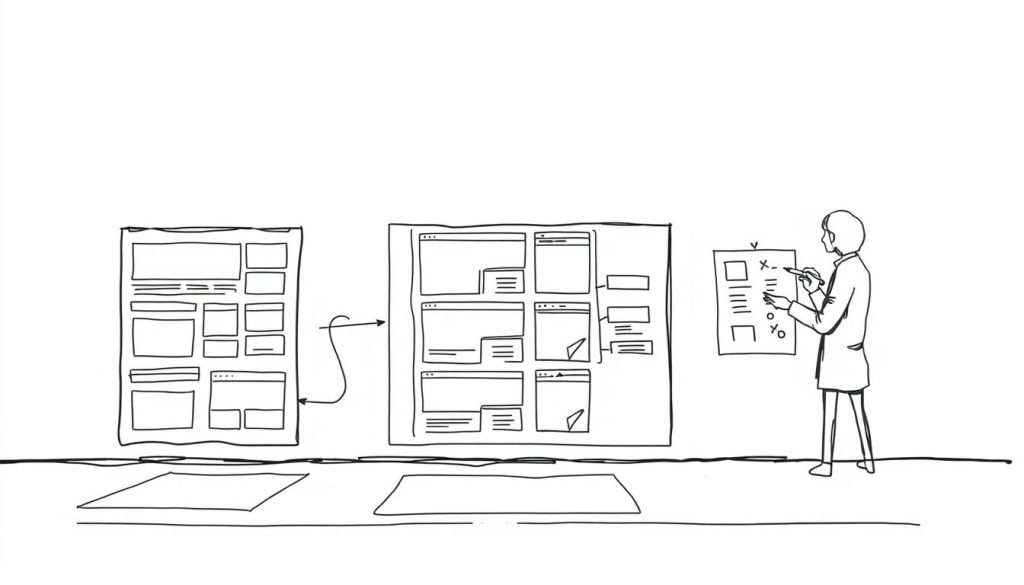Creating a professional-looking website can seem daunting, but with a clear guide, you can achieve your online goals. In today’s digital age, having a website is crucial for businesses, individuals, and organizations alike.
Whether you’re a beginner or an experienced developer, this comprehensive guide will walk you through the essential steps to create a website that meets your needs. From understanding the basics to launching your site, we’ll cover everything you need to know.
Key Takeaways
Table of Contents
- Understand the basics of website creation
- Learn how to plan and design a website
- Discover the best tools and resources for building a website
- Get tips on launching and maintaining your website
- Explore best practices for optimizing your website’s performance
Understanding the Basics of Website Creation
Creating a website from the ground up requires a solid understanding of the basics, including the different types of websites and the tools needed to build them. As you embark on your diy website development journey, it’s crucial to grasp these fundamental concepts to ensure your website is effective and user-friendly.
When it comes to building a website, the type of site you want to create plays a significant role in determining its structure and functionality. Understanding the different types of websites and their purposes is essential for a successful online presence.
Different Types of Websites and Their Purposes
Websites can be broadly categorized into several types, including e-commerce sites, blogs, portfolios, and informational websites. Each type serves a unique purpose: e-commerce sites are designed for selling products online, blogs focus on content publication and engagement, portfolios showcase creative work, and informational websites provide details about a business or organization.
Essential Tools and Resources You’ll Need
To start your beginner website building steps, you’ll need to gather essential tools and resources. This includes registering a domain name, selecting a web hosting service, and choosing a Content Management System (CMS) or website builder that suits your needs. Familiarizing yourself with these tools will streamline your website building process.
Setting Realistic Goals and Timeline
Setting realistic goals and a timeline is vital for the successful completion of your website. By breaking down your project into manageable tasks and establishing milestones, you can track your progress and stay on schedule. This approach will help you avoid common pitfalls and ensure your website is launched on time, following a comprehensive website building tutorial.
By understanding these basics and taking a structured approach, you’ll be well on your way to creating a website that meets your needs and resonates with your target audience.
Planning Your Website Structure and Content
Before diving into website development, it’s essential to plan your website’s structure and content. A well-planned website ensures a smooth user experience and helps achieve your online goals.
Defining Your Target Audience and User Needs
Understanding your target audience is crucial for creating a website that meets their needs. Identify demographics, preferences, and behaviors to tailor your content and design. Consider what actions you want your users to take and design your website accordingly.
Creating a Site Map and Navigation Flow
A site map helps organize your content and improves navigation. It ensures that visitors can easily find the information they’re looking for. A well-designed navigation flow enhances user experience and encourages exploration.
Writing Effective Web Copy
Your web copy should be clear, concise, and engaging. Use a friendly tone and focus on the benefits you offer to your audience. Effective web copywriting can significantly enhance user engagement and conversion rates.
Sourcing and Optimizing Images
Images play a vital role in enhancing your website’s visual appeal. Use high-quality, relevant images and optimize them with alt tags and descriptive text to improve SEO. Optimized images can boost your website’s search engine rankings.
Preparing Content Strategy and Assets
Develop a content strategy that aligns with your goals and audience needs. Plan your content types, such as blog posts, videos, or infographics, and create a content calendar. Organize your assets, including text, images, and videos, to ensure easy access and consistency.
| Content Type | Description | Benefits |
|---|---|---|
| Blog Posts | In-depth articles on specific topics | Improves SEO, establishes authority |
| Videos | Visual content for tutorials or explanations | Enhances engagement, improves understanding |
| Infographics | Visual representations of data or information | Easy to consume, shareable |
How to Build a Website from Scratch: Technical Setup
Setting up your website technically is a crucial step in bringing your online presence to life. This phase involves several key steps that lay the foundation for a functional and secure website.
Choosing and Registering a Domain Name
Your domain name is your website’s address on the internet. It’s essential to choose a name that is memorable, easy to spell, and reflects your brand or website’s purpose. Once you’ve decided on a domain name, you’ll need to register it through a domain registrar. Ensure that the registrar is reputable and offers good customer service.
Tips for Choosing a Domain Name:
- Keep it short and memorable
- Avoid numbers and hyphens if possible
- Choose the right domain extension (.com, .net, .org, etc.)
Selecting the Right Hosting Provider
Your hosting provider stores your website’s files and makes them accessible to the public. When selecting a hosting provider, consider factors such as reliability, customer support, scalability, and pricing. There are various types of hosting, including shared hosting, VPS hosting, and dedicated hosting.
Consider your website’s needs and choose a hosting plan accordingly.
Installing a Content Management System (CMS)
A CMS makes it easy to create, manage, and modify content on your website without needing to know how to code. One of the most popular CMS options is WordPress.
WordPress Setup Guide
WordPress is user-friendly and highly customizable. Most hosting providers offer 1-click WordPress installations. Once installed, you can choose a theme, install plugins, and start creating content.
Alternative CMS Options
While WordPress is a popular choice, other CMS options like Joomla, Drupal, and Magento are also available, each with their own strengths and suited for different types of websites.
Configuring Basic Technical Settings
After installing a CMS, you’ll need to configure basic technical settings to ensure your site is secure and functions properly. This includes setting up SSL certificates, configuring permalinks, and optimizing performance.
By following these steps, you’ll have a solid technical foundation for your website, enabling you to focus on creating great content and growing your online presence.
Designing Your Website’s Look and Feel
The design of your website is the first thing visitors notice, making it essential to get it right from the start. A well-crafted design not only captures attention but also enhances the user experience, driving engagement and conversions. As you create a website step by step, designing its look and feel is a critical phase that requires careful consideration of various elements.

Selecting and Customizing a Theme or Template
Choosing the right theme or template is the foundation of your website’s design. It should align with your brand identity and be flexible enough to accommodate your content. When selecting a theme, consider factors like responsiveness, customization options, and compatibility with your chosen CMS.
Creating a Cohesive Color Scheme and Typography
A cohesive color scheme and typography are crucial for a professional-looking website. Your color scheme should reflect your brand, while typography should be clear and readable across different devices. This consistency enhances the user experience and reinforces your brand identity.
Designing Responsive Layouts for Mobile and Desktop
With the majority of web traffic coming from mobile devices, a responsive design is no longer optional. Your website should adapt seamlessly to different screen sizes, ensuring that content is accessible and visually appealing on both mobile and desktop devices.
Adding Navigation Menus and User Interface Elements
Intuitive navigation and well-designed UI elements are key to a positive user experience. Your navigation menu should be clear and concise, making it easy for visitors to find what they’re looking for. Other UI elements, such as buttons and forms, should be designed with usability in mind.
By focusing on these design aspects, you’ll be well on your way to creating a website that not only looks great but also provides a solid foundation for your online presence, following a comprehensive website building guide.
Implementing Essential Website Functionality
As you start a website on your own, focusing on essential functionalities will help you create a more engaging and secure online platform. This involves several key steps that not only enhance user experience but also improve your site’s visibility and security.
Creating Key Pages and Content Sections
Every website needs certain key pages to effectively communicate its purpose and engage visitors. These typically include a homepage, about page, contact page, and services or products page. Creating clear and concise content for these sections is crucial. Ensure that your messaging is consistent across the site and tailored to your target audience’s needs.
Adding Contact Forms and Interactive Features
Interactive elements like contact forms, feedback mechanisms, and social media integrations are vital for engaging your audience. These features allow visitors to communicate with you easily, fostering a connection between your brand and its users. When adding these elements, consider user experience and ensure that they are intuitive and accessible.
Implementing Basic SEO Practices
Search Engine Optimization (SEO) is critical for improving your website’s visibility on search engines. Basic SEO practices include optimizing page titles and meta descriptions, creating search-friendly URLs, and producing high-quality, keyword-rich content.
Optimizing Page Titles and Meta Descriptions
Page titles and meta descriptions are crucial for SEO as they help search engines understand the content of your pages. Ensure that your titles are descriptive and include target keywords, while meta descriptions should be compelling and encourage click-throughs.
Creating Search-Friendly URLs and Content
Using descriptive, keyword-rich URLs can improve your site’s search engine rankings. Similarly, content should be created with a focus on relevance, quality, and keyword optimization to enhance SEO performance.
Setting Up Website Security Measures
Website security is paramount to protect both your site and your users from potential threats. Key security measures include installing an SSL certificate to enable HTTPS, regularly updating your Content Management System (CMS) and plugins, and using strong, unique passwords.
By implementing these essential functionalities, you’ll be well on your way to designing a website from the ground up that is not only engaging and user-friendly but also secure and optimized for search engines.
Conclusion: Launching and Maintaining Your Website
Launching your website is a significant milestone in your online journey. After completing the steps outlined in this web development tutorial, you’re now ready to make your site live and accessible to the world. Review your site’s functionality to ensure all elements are working as expected.
To maintain your website, regularly update your content and check for broken links. Implementing basic SEO practices will also help improve your site’s visibility on search engines. For those who are building a website for beginners, it’s essential to stay committed to your site’s maintenance and be open to learning and adapting to new trends and technologies.
By following this diy website creation guide, you’ve taken a significant step towards establishing a professional online presence. Continue to monitor your site’s performance and make adjustments as needed to ensure it remains secure and relevant to your audience.

